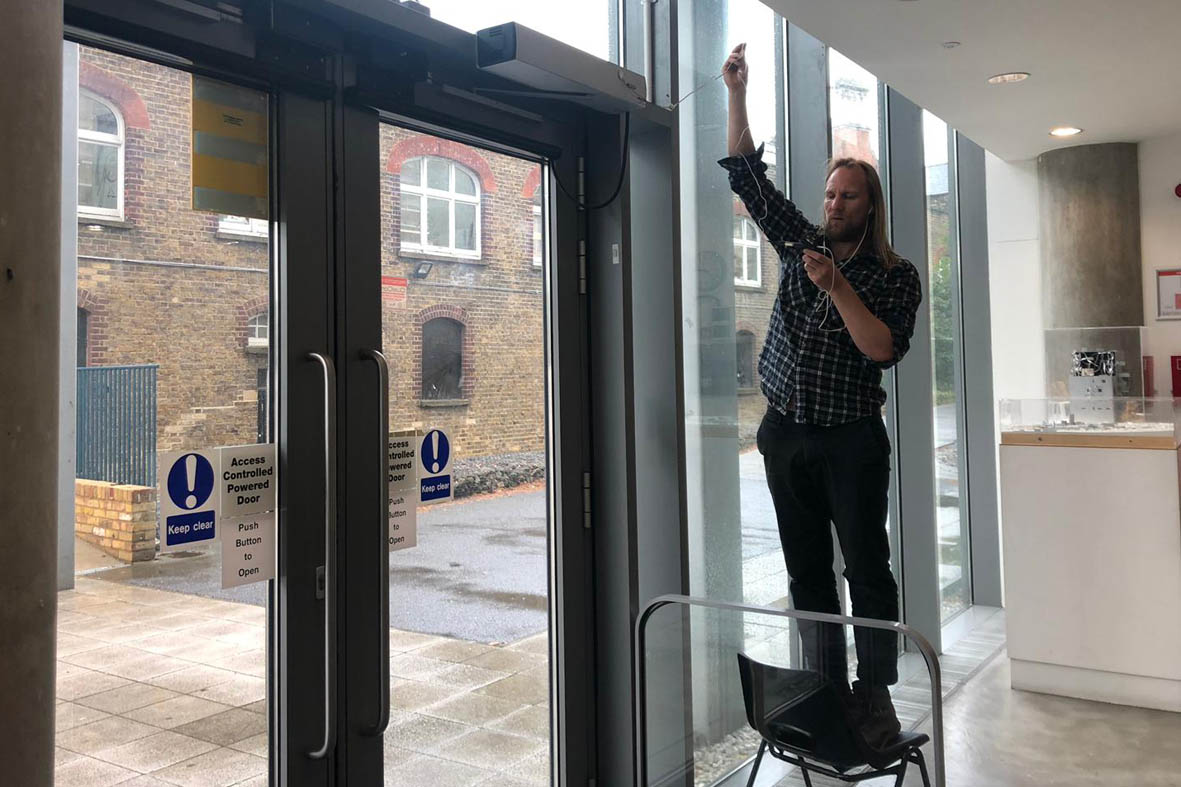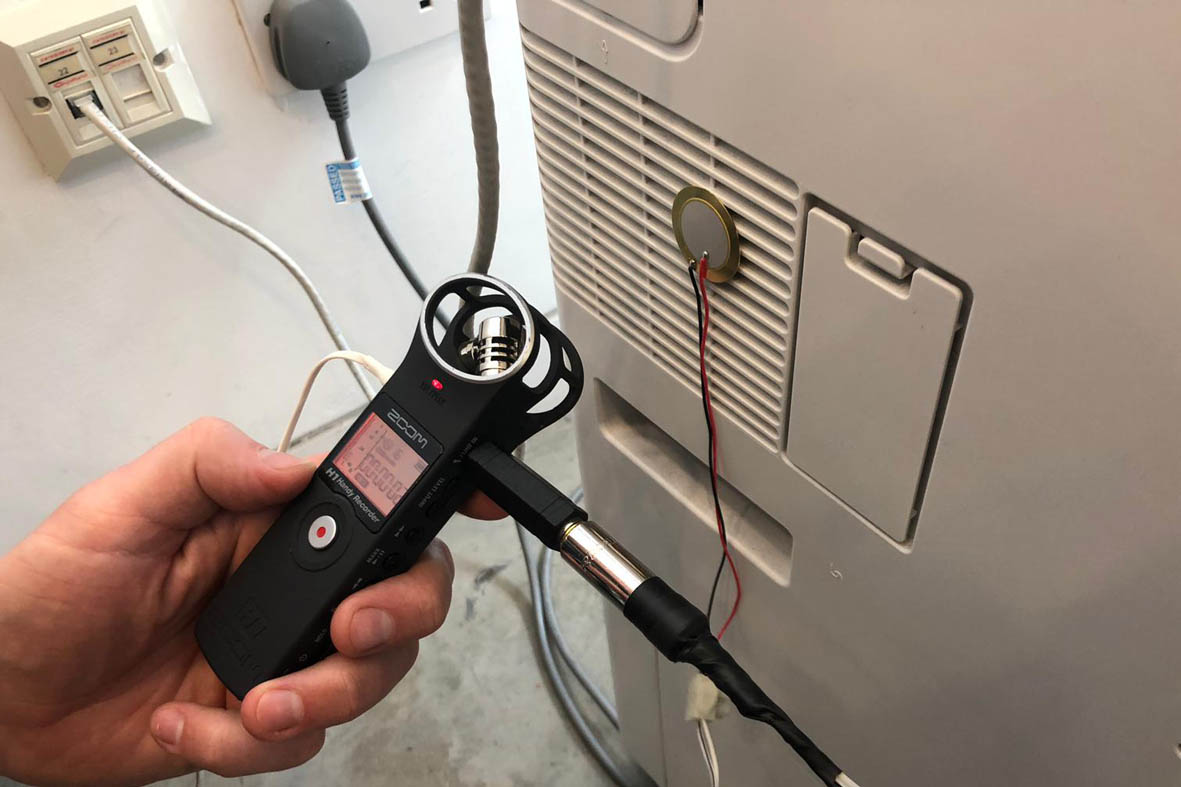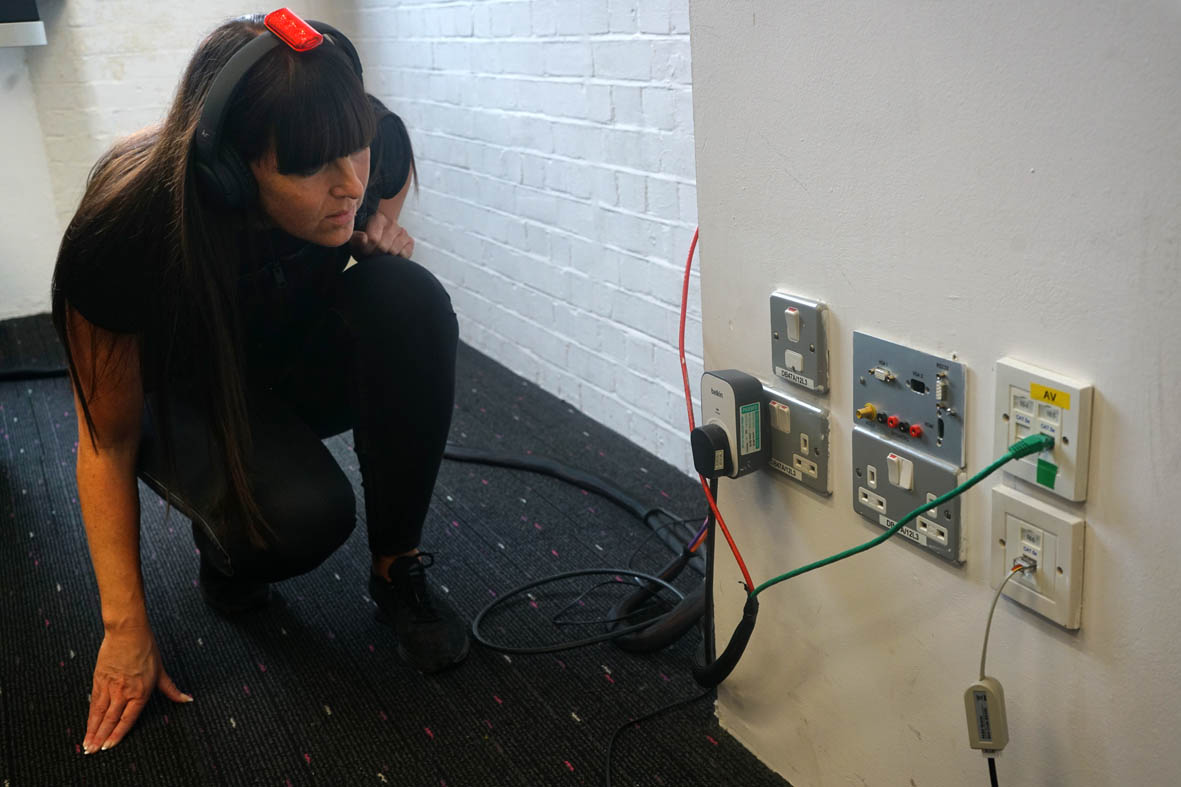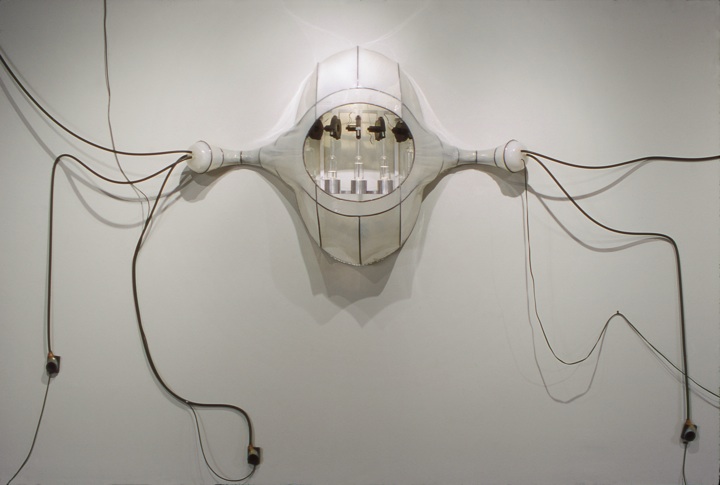Acoustic Fields
produced by, Jonny Fuller-Rowell
This practice-based research investigates how the sounds of functioning technological objects mediate our experience of an environment. By combining machine vision (to track a persons position in space) with amplified technological sounds, usually experienced unconsciously as 'background relations',(1) it seeks to explore how these sounds mediate the audiences' perception of space and of the objects themselves. This prompted the following research questions; 1.What happens when you amplify and isolate sounds from within their environment? 2.How does our understanding of human-technology relations change when objects which function as background relations move into our conscious awareness. 3.Can we develop a different understanding of functioning technological objects through sound? 4.Can our sensitivity to these sounds / objects continue beyond this experience, leading to a hightened awareness in everyday environments?
Video documentation of Acoustic Fields in lecture theatre RHB 144, particpant listening to sound of technology in the room.
Acoustic Fields (2019) is a site-specific installation in Lecture theatre RHB 144 that attempts to enhance the viewers awareness of the technological devices and systems that are present in the space, constantly working, even when the lecture theatre is not in use. This research project was prompted by the exercise 'at the border of self and other',(3, part of which asked participants to close their eyes for 90 seconds while touching the finger tips of a person standing directly in front of them. My predominant perception was how the numerous technological sounds dominated the acoustic environment around me. The whirring projector, the creaking radiator, the humming computer, I was connected to a space mediated by and through technology. Acoustic Fields explores these human-technology relations by amplifying and isolating the sound of each object, in relation to a person's position in the space.
Our environment is more and more subjected to man’s management and is becoming a kind of extension of humanity, this has developed into an experience of 'being' that is dominated by technology, this dominance has prompted philosophers to review our sense of how we experience 'being in the world'(2) in this new context. Don Idhe's Post-phenomenological theory explores our developing relationship with technology and proposes four categories of experience.(4)
Embodiment relations: technologies form a unity with a human being, such as wearing a pair of glasses or using a phone, we act through the technology.
Hermeneutic relations: relations in which technologies form a unity with the world, and humans are directed by there representation of it, such as MRI scan that represents brain activity or the beeping of a metal detector.
Alterity relations: humans interact directly with technologies with the world in the background, such as getting money from a cash machine.
Background relations: technologies are the context for human experiences and actions, rather than being directly experienced themselves. The sound of air conditioning units, fridges, computers.
It may appear from this list of human-technology relations that we would be extremly conscious of the role that technology plays in our world view, we are constantly interacting with a myriad of useful and perhaps not so useful technologies, however Martin Heidegger suggests that most perceptual experience is unconscious. Perhaps Heidegger's most profound theory was 'tool analysis' in Being and Time (1927), which argues that, for the most part we are not encountering things as 'present in our minds'. As philosopher Graham Harman summaries,
"Heidegger attempts to show that for the most part we deal with things as the unconscious background. If you're thinking about something it's usually because something has gone wrong. We are constantly flipping between 'presence at hand' and readiness to hand”. He highlights Heidegger's main point which is that “the background is more important than the foreground. 'Being' is that which withdraws. Anything we are conscious of is just a thin superficial film, all the action is happening underneath."(5)
Acoustic Fields investigates our relationship with objects in space by switching our perception of them between 'presence at hand' to 'readiness to hand, conscious to unconscious. By drawing our attention to these background sounds of technology in the everyday environments, we become more sensitive to how our unconscious meditates our experience of 'being the world'. Asking questions like 'how does the hum of the projector make us feel', anxious, uneasy, comforted...?
These objects have a presence, a power of their own that effects us, this work highlights their existence in relation to ourselves but as Graham Harman in his object-orientated philosophy(6) has proposed, objects exist independently of human perception, and the existence of these objects is not threatened by the existence of others. Moreover, he considers the relationship between a human being and an object to be the same as that between two or more objects. He refutes the concept of an anthropocentric world, where human beings are in a central, and privileged position. His object-orientated philosophy suggests that while an object may have properties which are useful to human beings in certain ways, they may also have other qualities, which are unknown, and even unknowable, to human beings.
By encouraging a phenomenological engagement with these objects i hope to suggest other more abstract definitions. We try to contain certain properties of objects because they are useful to us and then grow to associate these properties with the definition of the object. But this is not a definitive description of the object, just a small part. A plug connects one device to another but also it might produce high frequency noises when overloaded or get very hot or even explode. This project aims to make visible these hidden qualities of technology in an attempt to question our comprehension of them.
Psychoacoustics is the scientific study of sound perception and audiology – how humans perceive various sounds. More specifically, it is the branch of science studying the psychological and physiological responses associated with sound, in essence how sounds make us feel. Anything that moves has a vibration. Though invisible, every aspect of our material world at the atomic level moves constantly. Wherever there is motion, there is frequency. Though inaudible at times, all frequencies make a sound. All sounds resonate and can affect one another. Sound is a powerful medium for change. Philosopher Walter Ong suggested that sound is more important than we realise. “Sound signals the present use of power, since sound must be in active production in order to exist at all. It tells us that something is going on.”(7) Our sense of the world is often referred to in visual language, (seeing equals understanding) however Ong proposes an alternate conception of our 'world view',
"We can perhaps start from a more generic concept, thinking of not merely a world view but a world sense...but I believe that another productive way to supplement our concept of world view is to move from the concept of world sense to the concept of world-as-presence...presence in the full sense of the term entails more than sensation. Insofar as it is grounded in the senses, it appears to be grounded in all of them simultaneously...In terms of presence we cannot achieve the precision we achieve by resort to the visual imagination for models representing the structures in consciousness. But by thinking of world-as-presence we gain in immediacy and in a certain kind of relevance."(8)
Ong points to a more phenomenological 'world view' grounded in the senses, however senses have their own qualities, each effecting perception in their own unique way. Sight presents surfaces, sound on the other hand, reveals the interior without the necessity of physical invasion. I can hear my fingers tapping on my computer keyboard but I can also hear it humming inside. Vision objectifies the world into objects and though sound also has this capacity it can also merge the sounds of objects into one. Sound has physical qualities which vision does not, it is energy that moves through the air as a pressure wave, you feel it in your body. The more energy an object has the more it vibrates and the louder it becomes. The farther a sound wave travels, the more it spreads, this makes it more difficult for us to hear. Our intuitive understanding of sound forms our construction of the space we live in, not in a reflective way but in a live experience of the world. You cannot observe a sound you have to experience it, react to it, if you stop to inspect it there is only silence. Sound artist and theorist Brandon LaBelle discusses the way humans interact sounds through vibrations in his essay Background Noise, Perspectives on Sound Art, where he highlights,
"The forceful and connective qualities instantiated through vibration are suggestive of how bodies may come into contact within environments, to form collectivities and initiatives. In this regard, vibration and the vibratory provide a material pathway for realizing radical forms of togetherness."(9)
Acoustic Fields brings into focus the ambient sounds in the lecture theatre. It asks us to consider the common experience and phenomenon of background noises produced by an array of electrical and mechanical infrastructures, such as heating, ventilation systems, projectors and computers, all of which introduce particular sonic elements to our architectural environments. A piezo element (or contact microphone) was used to record audio vibrations through contact with solid objects.
Object recordings with a piezo contact microphone.
Unlike normal air microphones, contact microphones are almost completely insensitive to air, transducing vibrations from only structure-borne sounds, thus heightening their material quality. By applying the microphone to specific technological objects in the space the artwork uses the 'material' sound pertaining to each object and amplifies them to an audible level via headphones. By using these sound recordings in conjunction with machine vision the artwork activates and deactivate objects depending on the position of a person in relation to the objects in space. The participants distance from an object mapped to its amplification so as a person moves closer it's sound will increase. Once installed participants were invited to experience the space with no introduction. Unguided written feedback from participants was collected and used in the findings.
Stills of Acoustic Fields in lecture theatre RHB 144, particpant listening to sound of technology in the room.
The work of sound artist Sabrina Raaf also draws us into these more peripheral forces, bringing focus onto ambient elements, such as background humming. Her elaborate sculptural work, Unstoppable Hum (2000) generates its own humming produced through a set of “fans” that blow air into corresponding glass jars filled partially with water. As Branden Labelle discuss in his essay 'Background Sounds',
"Raaf ’s interest is to counter the rather monotonous background hum of rooms with a “musical” addition, Unstoppable Hum operates through a type of inversion; by appropriating background elements and manifesting them through a foregrounded sonority...the background hum, in other words, may actually be something to listen to."(10)
Raaf states she interested in the interplay between background-foreground relations, she states “what interests me is how aware we are of the immediate atmosphere we breathe, we are immersed in...and heightening our awareness of all these flows”,(11) however by appropriating these sounds they become something new, separated from their original source, Acoustic fields amplifies rather than alters, investigating how objects transition in and out of consciousness and ultimately how that affects our perception of space.
Sabrina Raaf, Unstoppable Hum (2000) Media: Steel, Rubber, Aluminum, Glass, Custom Electronics, Dimensions: 84” x 70” x 12”
By situating this artwork in an everyday environment, as a opposed to an art gallery, the intention is to gain a more permanent perceptual change. Rather than an isolated experience in the gallery the viewer questions their own experience of everyday space. This intention is similar to John Cage's 4'33' (1952) where each 'performer' quietly listens with full awareness to the sounds audible at that moment, making the distinction between hearing (passive) and listening (active).
David Cunningham's The Listening Room (2003), also attempts to make the audience more conscious of what they are 'listening' to, to expose the space itself by magnifying the sounds of the room. He states, “for myself the most important quality is that it is a situation, which is physically referential both to external contexts and to its own structure.”(11) His work allows the resonant frequencies of a space to become audible, however instead of isolating these sounds Cunningham's system merges these sounds into one ambient cacophony escalating in amplitude until triggering the noise gate and beginning again.
John Cage, 4'33'' (1952) score, 11 x 8 1/2" (27.9 x 21.6 cm) sheet paper. / David Cunningham, The Listening Room (2003) Installation view in Chisenhale Gallery, London.
Conclusion:
When objects move in our consciousness from background to alterity relations, it has a profound effect on our experience of being in a space. What was initially a silent space becomes activated, full of noise and life. The objective mind is overridden by a phenomenological bodily enquiry, expanding our definition of objects and their qualities. Even an unconscious awareness that an object might have other properties changes our perception of an objects identity, moving away from our definition as a tool, into an independent entity capable of other relationships in which the human is no longer central.
Acoustic Fields explores these acoustic relational approaches and concerns; as if sound is already unfolding a broader horizon, leading the viewer to a heightened awareness of what is present, as well as what is no longer there. The vibrating, resonating movements of sound draw us toward this greater view, and importantly, put us into dialogue with the surrounding environment. A dialogue that is embodied, sensed. This project also explores sound according to spatial thinking, recognising that the objects are an important part of the architecture's spatial constructions. Anything that moves has a vibration, though invisible, every aspect of our material world at the atomic level moves constantly. Sound propagates and travels becoming a spatial figure, and in doing so links the materiality of its source with the acoustic dimension of space, activating our surroundings, and animating our experience.
The question of whether Acoustic Fields can instigate a longer lasting perceptual change / understanding is speculative. Can this heightened awareness be taken outside the lecture theatre, can our sensitivity to sounds / objects continue beyond this experience? As one participant wrote, “after experiencing this piece, my perception was heightened for sure, I could hear the hum of the projector and the click of the radiators when I sat in a different lecture space the following day”.(12) Whether this perceptual awareness lasts for longer than a few days or whether this is restricted to specific objects present in the artwork, needs to be followed up. However, another participant alludes to a more general shift in understanding to a less human centred view. “This artwork made me pay attention to hidden sounds and made me feel sensitive to objects that are usually invisible to me”(13). The use of sound is critical as it activates a bodily awareness enabling a physical connection through sound waves, “this is the first time I have experienced an artwork that focusses on sound and it was effective. It made me reconsider the sound vibrations that objects make and made me realise that so many objects are still working/functioning even in an an empty auditorium”.(14) What the findings also provided were new opportunities for development, experimenting with the sounds in relationship to the space and the human. “The work made me more aware of the workings of objects, the isolation worked but I would have liked to hear them all at the same time”.(15)
Overall, I think this project highlights the importance of hearing / sound in a metaphysical sense of being, in both a phenomenological and conceptual capacity. It's effects are powerful but what is more interesting perhaps is what those affects are on both our psychological and philosophical selves. Research into this is still relativity new and controversial. Can sounds we can hardly hear or cannot hear at all, be affecting us? A study by Japanese artist and scientist Tsutomu Ōhashi on inaudible high-frequency sounds and their affect on brain activity, know as the 'hypersonic effect',(16) claimed that although humans cannot consciously hear ultrasound (sounds at frequencies above approximately 20 kHz) the presence or absence of those frequencies has a measurable effect on their physiological and psychological reactions. With the prevalence of such sound in our daily environments what might be the long term affects on our 'sensitive selves'?
- Ihde, D, Technology and the Lifeworld: From Garden to Earth, Indiana University Press (May 22, 1990) p.272
- Heidegger, M Being and Time, translated by J. Macquarrie and E. Robinson. Oxford: Basil Blackwell, 1962 (first published in 1927 p.152).
- Pritchard, H, Computational Arts-Based Research and Theory, excersise 'at the border of self and other'
- Ihde, D, Technology and the Lifeworld: From Garden to Earth, Indiana University Press (May 22, 1990) p.248
- Harman, G, lecture 'Greenberg, Heidegger, McLuhan, and the Arts' given to the Pacific Northwest College of Art (PNCA), Portland Oregon
- Harman, G, blog https://doctorzamalek2.wordpress.com/2010/07/23/brief-srooo-tutorial/
- Ong, WJ, Research paper 'World as View and World as Event’ (1969)
- Ong, WJ, Research paper 'World as View and World as Event’ (1969).
- LaBelle, B Background Noise Second Edition Perspectives on Sound Art p.302
- LaBelle, B Background Noise Second Edition Perspectives on Sound Art p.302
- Cunningham, D website http://www.stalk.net/piano/alisten.htm
- Audience feedback.
- Audience feedback.
- Audience feedback.
- Audience feedback.
- Oohashi, T, Inaudible High-Frequency Sounds Affect Brain Activity: Hypersonic Effect, (2000).
Annotated bibliography:
HARMAN, G. (2002). Tool-Being: Heidegger and the Metaphysics of Objects. Open Court Publishing Co, U.S. Harman explains Heidegger's famous tool-analysis and then extends it beyond Heidegger's theory of human practical activity to create an ontology of objects themselves. Every reader of Being and Time is familiar with the opposition between readiness-to-hand (Zuhandenheit) and presence-at-hand (Vorhandenheit), but commentators usually follow Heidegger's wishes in giving this distinction a limited scope, as if it applied only to tools in a narrow sense. Graham Harman contests Heidegger's own interpretation of tool-being, arguing that the opposition between tool and broken tool is not merely a provisional stage in his philosophy, but rather its living core. I really liked Harman style finding it accessible and engaging. His Object Orientated philosophy constitutes a main part of my research.
HARMAN, G. (2013). Lecture: 'Greenberg, Heidegger, McLuhan, and the Arts'. Pacific Northwest College of Art (PNCA), Portland Oregon.
HARMAN, G. (current). blog https://doctorzamalek2.wordpress.com/2010/07/23/brief-srooo-tutorial/
HEIDEGGER, M. (1962) (first published in 1927). Being and Time. Translated by J. Macquarrie and E. Robinson. Basil Blackwell, Oxford. “One of the most important philosophical works of our time, a work that has had tremendous influence on philosophy, literature, and psychology, and has literally changed the intellectual map of the modern world.” (goodreads.com) This is obviously an important book for anyone interested in analysing the concept of Being. While it's hard to read I found by reading what other philosophers write about him helped me a lot. His assertion that “the background is more important than the foreground. “Being' is that which withdraws” was the conceptual starting point of this research.
IHDE, D. (1990) Technology and the Lifeworld: From Garden to Earth. Indiana University Press. This was a very important book for laying out the context of this project. He outlines the our various relationships with technology and explains how they mediate our experience of 'being'. I found his categories of embodiment, hermeneutic, alterity and background relations a very clear and compelling which encouraged me to think about my relationship with technology in an engaged more conscious manner.
IHDE, D. (2007) Listening and Voice: Phenomenologies of Sound. State University of New York Press.
ONG, WJ. (1969). Research paper: 'World as View and World as Event’. St. Louis University.
OOHASHI, T. (2000). Research paper - Inaudible High-Frequency Sounds Affect Brain Activity: Hypersonic Effect. Journal of Neurophysiology.
PRITCHARD, H. (2018). 'At the border of self and other'. Computational Arts-Based Research and Theory exercise, Goldsmiths university.
LABELLE, B. (2015). Background Noise Second Edition Perspectives on Sound Art. Bloomsbury Academic,London. Background Noise follows the development of sound as an artistic medium and illustrates how sound is put to use within modes of composition, installation, and performance. He weaves architecture, environments, and the specifics of location into the work of sound, with the aim of formulating a history and understanding of sound art. He is interested in the dynamics of art to operate spatially which was an importance accept of this project. I found his writing poetic and a pleasure to read.














































































